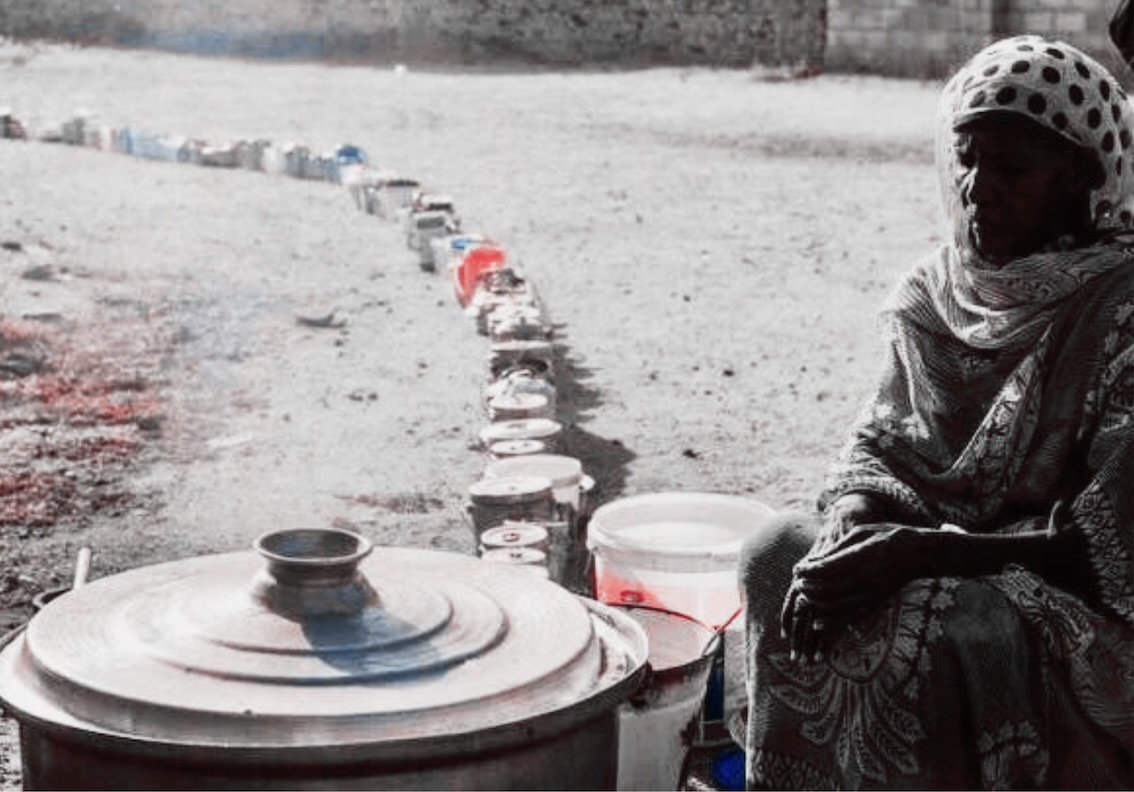Sudan Conflict Monitor #18

6 March 2025
The Sudan Conflict Monitor is a rapid response to the war in Sudan written through a peacebuilding, human rights, and justice lens, reflecting on the most important stories in the country. Please share it widely.
Powered by Ayin, Human Rights Hub, and the Sudan Transparency and Policy Tracker
In this issue:

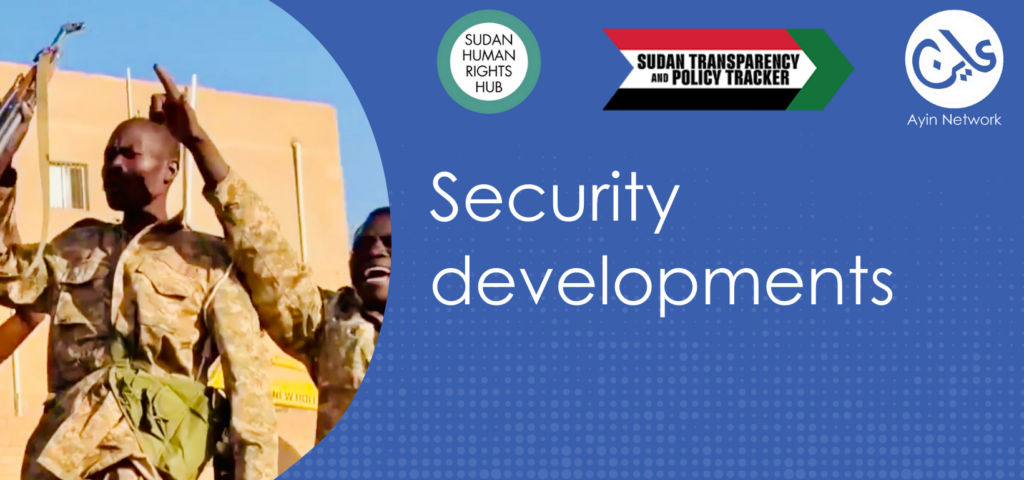
1. Security Developments
SAF makes progress in Khartoum, Jazeera, and El Obeid
The April 2023 conflict continues with no sign of abatement as Ramadan begins. Each of the warring parties maintains ambitions to either solidify or expand their territorial control across Sudan in anticipation of the holiday season. The dispute has led to heavy clashes in several hotspots—Khartoum and Jazeera, El Fasher and the North Darfur desert frontline, and along several routes across the Kordofan states. Ground fighting is often supplemented by aerial bombardment, with disruptions to civilian life caused by waves of Sudanese Armed Forces (SAF) airstrikes across RSF-controlled Darfur and Rapid Support Forces (RSF) long-range drone strikes upon dams, electricity plants, and other military and civilian targets in the cities of Central and Northern Sudan. All sides additionally continue with recruitment and re-supply to fuel their respective war efforts. Particular attention is placed upon the transfer of increasingly technologically sophisticated weaponry along ever-shifting and difficult-to-trace supply lines entering Sudan, especially over the past few months.
The ongoing fighting has exacted a devastating impact on the civilian population. Both Sudanese and international actors have called for a temporary ceasefire—or humanitarian pause—over the month of Ramadan. However, SAF is keen to carry on the momentum of its successes over the past few months and has been generally skeptical of peace talks, continuing to believe in its chances of long-term victory through attrition. RSF leaders, on the other hand, may be open to a respite in regrouping and reorganising a loose mosaic of ground forces remaining in Central Sudan. Yet, RSF has nevertheless exhibited signs of building up toward various counterattacks timed for the early days of Ramadan, paired with its ongoing siege of El Fasher, and may intend to carry these plans to fruition in lieu of a pause. Interlocutors both among the warring parties and in the international community have well-acknowledged waning chances of a ceasefire in the near future.
Khartoum and Jazeera
Previous analysis by the Sudan Conflict Monitor has treated Khartoum and central Sudan frontlines, Jazeera in particular, as a single conflict ecosystem due to the fluid movement of fighters and material in mutual reinforcement between the two locations. Since mid-September 2024, SAF and aligned forces have undertaken a heavy offensive that has yielded results by December 2024 in recapturing key locations such as Al-Jaili Refinery and the Qarri Free Zone, parts of Bahri including a connection to the besieged Bahri Signal Corps and General Command HQ over the Blue Nile river, progress along al-Mogran and downtown Khartoum areas, Wad Madani city, and various rural swaths of Jazeera and Sennar states. These successes have been lauded by SAF media as approaching a near success in the complete re-capture of the capital tri-city area, if not the entire Central Sudan.
The RSF side has indeed suffered heavy setbacks over the past months, attributing failures to collapses in communications, logistics chains, and command and control. The loss of several prominent commanders to highly precise SAF drone strikes, paired with the increasing fear of individual units being isolated due to SAF’s progressive capture of key bridges in the Khartoum and Jazeera areas, has only exacerbated these problems. Nevertheless, sources in both SAF and RSF acknowledge that RSF High Command has heavily invested in the resolution of internal problems among units fighting in the capital—for instance, stemming the flow of fighters retreating over the vulnerable Jebel Awliya dam passageway and instead redeploying them either northward to Omdurman or westward to North Darfur and shoring up salary backlogs—and that RSF ground presence in Eastern Khartoum, Southern Khartoum, parts of East Nile and Northern Bahri, and Western Omdurman remains formidable. Both sides expect heavy fighting in the capital in the coming weeks.
North Darfur
Much international and Sudanese domestic attention has been placed upon RSF’s ongoing siege of El Fasher. As forecasted by previous iterations of the Sudan Conflict Monitor, RSF’s offensive strategy still appears to be geared toward ground progress from the southeastern and northwestern sectors of the city, seeking to cut off SAF, the Joint Forces, and popularly mobilized defenders in positions located in the neighborhoods surrounding Zamzam and Abu Shouk IDP camps, in the Southwestern and Northeastern sectors of the city, respectively. RSF’s ground incursions have increasingly breached the outer perimeters of SAF’s 6th Division HQ (located roughly in the center of the city), although SAF is beginning to relocate key officers, communications equipment, and heavy weaponry either toward El Fasher airport or northwest to the UNAMID HQ. Over the past two weeks, RSF has also proceeded to both surround and directly attack Zamzam IDP camp, within which it believes the Joint Forces are recruiting and staging forces, leading to several raids into the perimeter of the camp itself. Airstrikes from the SAF side and shelling and drone usage from the RSF side continue to significantly hamper civilian movement and livelihood inside the city, with little chance for reprieve.
Often forgotten, however, are the intense clashes across the North Darfur desert frontline, ranging from eastern Chad to southeastern Libya to Darfur – Northern Sudan border areas. At the end of December 2024, a surprise offensive by the Joint Forces with SAF aerial support captured five RSF bases in North Darfur border regions with Libya and Chad, including the three most significant RSF logistics bases: El Zurug 1, El Zurug 2, and Bir Mirgui. In response, by January 2025, RSF committed significant resources for a counteroffensive led personally by second-in-command Abdelrahim Dagalo, engaged in fighting around the axis from Malha to Mellit, El Fasher city itself, and in the western localities of North Darfur (Dar al-Zaghawa). Paired with the intensified ground fighting, SAF has heavily bombed RSF transit points such as Al Kuma locality while RSF has used its drones to target Joint Forces positions in El Tina and al-Dabba.
Kordofans
Senior SAF interlocutors claim that victory in Central Sudan is by no means a stopping point for the war. They say they intend to re-establish ground presence in Western Sudan by force. The critical Kosti to El Obeid road across White Nile and North Kordofan is a litmus test, with SAF and Joint Forces’ mixed “Al-Sayyad” battalion having fought key battles against RSF in locations such as Tendelti and Um Rawaba over the past months. Although SAF announced that it captured large stretches of the road and Er Rahad town, it faces challenges in North Kordofan after breaking the RSF’s siege of El Obeid city. SAF officials said they intend to operationalize El Obeid airport and pursue several land routes leading to North, East, and South Darfur in the longer term.
RSF, in turn, continues the heavy siege on the SAF 22nd Division HQ in Babanusa, West Kordofan. As of January 2025, RSF has also attacked En Nahud, West Kordofan, for at least five days, albeit with little media coverage. Ground sources in West Kordofan, North Kordofan, and White Nile continue to report fears of piecemeal RSF presence and errant raids, noting that SAF’s public announcements of progress have done little to prevent an overall environment of insecurity.
As of early 2025, SAF has engaged in a new set of clashes with SPLM-N-Al Hilu over the road between Dilling and Kadugli, South Kordofan, having exchanged artillery barrages and periodic ground assaults in the latter city, especially. SAF appears to want to connect the road between the two cities in the coming weeks but faces staunch opposition. New questions have also been raised about the status of SAF’s 10th division based in Abu Jubayha, with consideration among SAF interlocutors as to whether the 10th division’s troop strength may be tapped into for upcoming forays in the Kordofans.
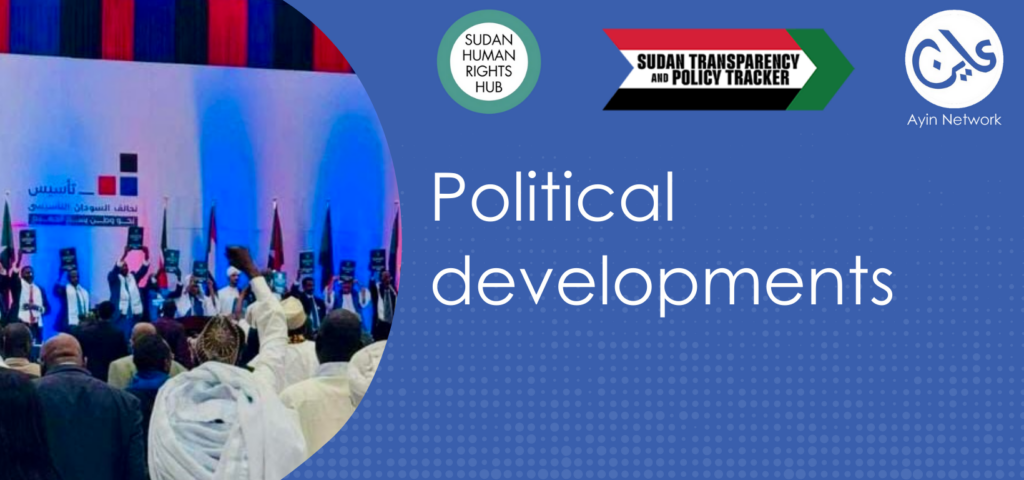
2. Political developments
Taqaddum splits
Sudan’s civilian opposition coalition, Taqaddum, has fractured over deep disagreements regarding the formation of a government in exile. Proponents of the initiative argued that it would create a legitimate alternative to the Port Sudan authority they view as illegitimate. Opponents contended that such a move would fragment the opposition, inadvertently legitimizing the RSF and complicating peace efforts.
After failed attempts to reconcile these differences, Taqaddum officially split, with the two factions now operating independently.
The faction committed to rejecting legitimacy for both the SAF and the RSF, while advocating for an immediate end to the war and the revival of Sudan’s democratic transition, has rebranded itself as Somoud—Arabic for Perseverance. Former Prime Minister Abdalla Hamdok continues to lead this group, which has since focused on reorganizing its ranks, broadening its base, and revitalizing outreach efforts—both domestically and internationally.
On February 21, 2025, the Rapid Support Forces, the Sudan People’s Liberation Movement-North under the leadership of Abdelaziz El Hilu, 22 smaller rebel movements, and political and civil society groups signed a charter for the formation of a new parallel Sudanese government. The charter calls for the creation of a secular, decentralised, and democratic state. Although the text offers appealing standards, the move has been criticized as a way for the RSF to promote its rehabilitation after committing serious atrocities on the ground. Critics have pointed out that the lofty rhetoric of the charter does not match the conditions imposed by the RSF on civilians under its control. Others have argued that the parallel government may contribute to the disintegration of Sudan.
Burhan tightens grip
In response to this emerging political challenge, on February 19, authorities in Port Sudan—controlled by the SAF and its allied security apparatus—announced sweeping amendments to the 2019 Constitutional Document. Though effectively nullified by the October 2021 coup, the SAF had continued to use it as a veneer of legitimacy.
The amendments:
- Extend the “transition” period by at least 39 months while removing all references to the FFC and RSF.
- Abolish the article mandating an investigation into the June 3, 2019, Khartoum massacre, replacing it with a vague general accountability clause with no actionable measures.
- Dissolve the Sovereignty Council, replacing it with a de facto military council controlled by the SAF. The new body consists of six members from the SAF, police, and intelligence agencies, three representatives of SAF-aligned armed groups, and two additional members with unspecified affiliations.
This military-controlled council has sweeping powers, including:
- Appointing and dismissing the judiciary, including the Chief Justice and Supreme Court justices.
- Selecting the auditor general.
- Handpicking the prime minister and cabinet members.
Indeed, shortly after the adoption of these amendments, an assistant to Burhan declared that the Transitional Sovereignty Council will appoint a prime minister “very soon.”
By eliminating civilian oversight and cementing military rule, these amendments effectively pave the way for General Abdel Fattah al-Burhan’s autocratic rule in post-war Sudan, sidelining any prospects for a democratic transition.
On March 4, former Prime Minister Abdalla Hamdok and the head of Somoud launched the Sudan Peace Appeal, outlining a series of steps to advance both the political and humanitarian processes. He called on the UN Security Council and the African Union Peace and Security Council to jointly convene Sudanese stakeholders—including the commanders of the Sudanese Armed Forces (SAF) and the Rapid Support Forces (RSF), armed movements, and civilian opposition democratic forces—to agree on an immediate humanitarian ceasefire.
Hamdok proposed that this meeting establish mechanisms to ensure humanitarian access and safe havens for civilians while promoting de-escalation and trust-building measures between the warring parties. He also urged both civilian and military actors to make concessions on transitional constitutional arrangements, emphasizing the need to empower a civilian technocratic cabinet to steer Sudan through stabilization, reconstruction, and ultimately, democratic elections.
Somoud’s plan further calls for rebuilding the military and security agencies into unified, depoliticized institutions, as well as implementing accountability measures for atrocity crimes committed during the war.
With Taqaddum fractured but rising from its dissolution as Somoud, the RSF-backed breakaway faction seeking legitimacy, and the SAF consolidating power through constitutional amendments, Sudan’s post-war trajectory appears increasingly dominated by militarized governance. Meanwhile, the emergence of groups like Al-Baraa Ibn Malik raises further concerns about the role of jihadist elements in shaping the country’s future.
The rise of Baraa Ibn Malik
Sudan’s Islamist Movement (SIM) continues to reveal its hand in planning and prosecuting the ongoing war, including by deploying jihadist brigades—of which the most prominent is Al Baraa Ibn Malik—alongside the SAF and by mobilizing popular support for the Popular Resistance recruitment campaign. At the same time, SIM has repeatedly voiced its discontent with the performance of SAF’s commander in chief and his intermittent openness to ending the war through negotiations.
Gen. Burhan, on the other hand, alternates more or less public recognition of SIM’s combat contributions to the army and rallying populations to its support while publicly rejecting SIM’s aggressive push for using the SAF as a vehicle for its return to power after the war.
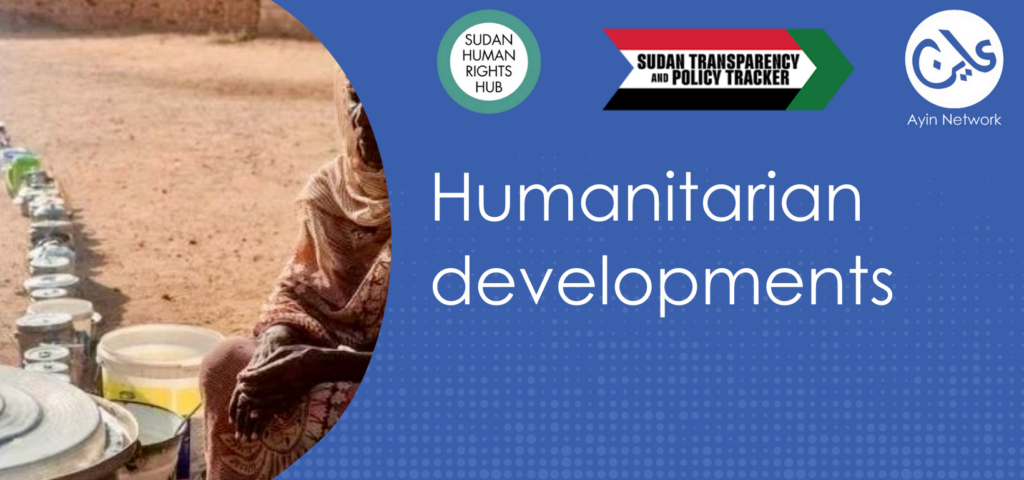
3. Humanitarian developments
US suspension of humanitarian aid
On January 24, 2025, US President Donald Trump signed an Executive Order that suspended all ongoing USAID programs pending a 90-day review. Overnight, multiple agencies and programs were issued stop work orders. Since then, an estimated 90% of contracts have been cancelled, and nearly the entirety of the staff of USAID has been placed on administrative leave. Although US Secretary of State Rubio has set up a framework for accessing waivers to allow critical, lifesaving work to continue, these are extremely difficult to get guidance on or process given the lack of staff to manage exemptions. Even where waivers have been issued, agencies have reportedly been unable to access cash from the Treasury to enable them to work. The Norwegian Refugee Council has been forced to cancel all US-funded activities, including some that had received a waiver, such as a program supporting nearly 700 bakeries in Darfur to provide bread to the population.
The expenditure has a serious economic impact for Sudan, which receives more than a fifth of total development assistance from USAID, according to the Center for Global Development. In Sudan, that amounts to 3% of gross national income, enough to cause a significant economic shock.
According to the Sudanese think tank Fikra, the US provided two-thirds of the funding for Sudan’s Emergency Response Rooms, disrupting their crucial food, medical, and sanitation work. As a result, 80% of soup kitchens run by the Emergency Response Rooms have been shut down, affecting an estimated two million people. For most of the beneficiaries, the food provided at the soup kitchens was “the only meal they get,” according to Hajooj Kuka, a spokesman for the Emergency Response Rooms. Volunteers at the emergency rooms are reporting that hungry people that they used to serve are knocking on their doors in desperation. In the words of one volunteer, “We expect to see a lot of people starving” very soon. In Dilling, South Kordofan, local organizations report that malnutrition-related deaths have occurred since the local community kitchens were forced to shut down.
The cut of funding to the emergency rooms is particularly gut-wrenching because these very local, hardworking volunteers are delivering aid at very low cost, and USAID had just been beginning a process to engage with them more directly, increasing efficiency, but these efforts to provide more locally accountable and efficient aid now seem doomed.
In eastern Sudan, three clinics serving 30,000 people have been forced to shut down due to the aid freeze. These are just three of 335 health facilities in the country that have been affected by the aid freeze.
The price of a kilo of peas in Darfur has almost tripled (from 1300 SDG to 3500 SDG) since the imposition of the order, and the prices of key staples in Khartoum have reportedly doubled due to the disruption of food aid.
Meanwhile, conflict and obstructions also continue to disrupt aid distribution. Médecins sans Frontières has announced that they have to close down their field hospital in Zamzam camp because of how dangerous conditions have become in light of the recent fighting. Food distributions have similarly not been possible over the last three weeks due to fighting.
If you are interested in helping to fill the gap, public contributions can be made to the ERRs through: https://mutualaidsudan.org
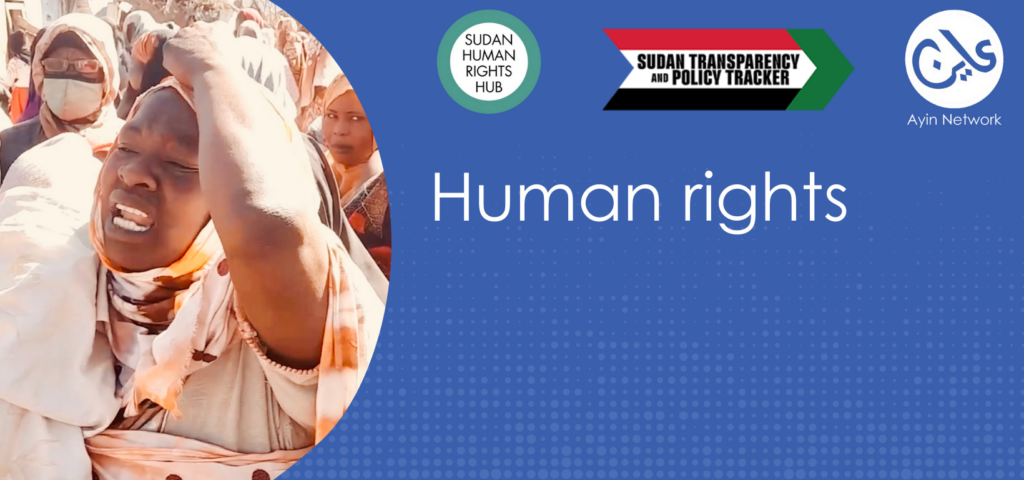 4. Human rights
4. Human rights
Attacks on civilians continue; retaliatory attacks
Both parties continue to carry out attacks on civilians. An explosion in Omdurman market reportedly killed 54 people and was attributed to the RSF. A week earlier, the RSF was accused of killing at least 70 at the Saudi Maternity Hospital in El Fasher.
Meanwhile, the UN Human Rights Office in Geneva said it has verified that at least 18 people, many Darfuri or Kordofani, including one woman, were killed by SAF in the Jaili oil refinery area and Khartoum North after they took control of the area.
In addition, a spate of retaliatory violence has been recorded in Al Gezira state since the SAF has advanced. A report by Human Rights Watch on February 25, 2025, details how militia forces affiliated with the Sudan Armed Forces killed 26 in Tayba village near Wad Medani in January. Ayin has also reported on these attacks, additionally reporting on the looting of more than 2,000 cattle. The Sudan Shield militia reportedly carried out the attacks, prompting concerns about their emergence as a potential violent proxy for the regime, specifically targeting the Kanabi community, an economic group comprised of farm labourers based in central Sudan.
Ayin also reported that in areas retaken by the SAF, there has been strong retaliation against those who were considered RSF collaborators. There have been credible reports that humanitarian volunteers who have no connection to the RSF have been put on lists of collaborators. There are reports that the Islamic Movement is planning retribution against those who it sees as sympathizing with the RSF, claiming that they have a list of 6,000 targets for retribution.
In this context, there are significant concerns that a new round of retaliatory attacks could occur if the army manages to fully retake Khartoum.
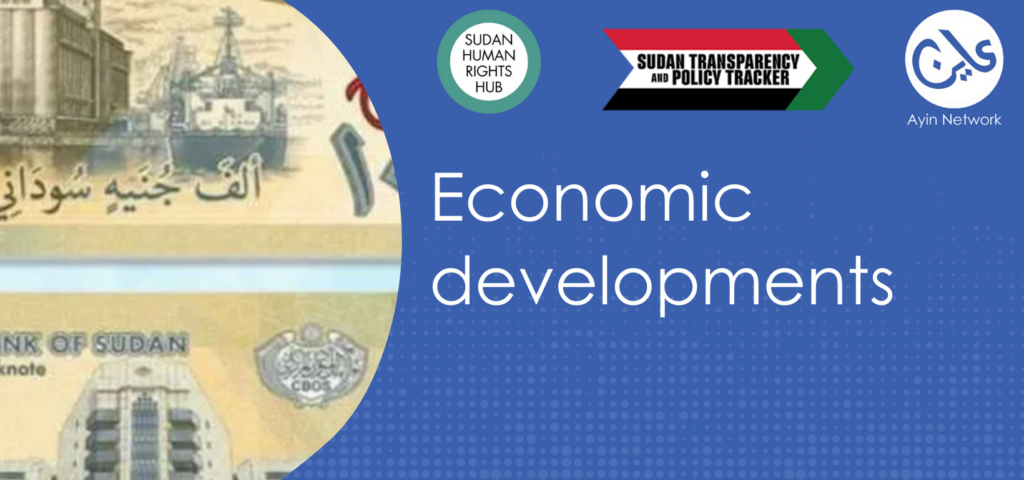
5. Economic developments
Army poised to take greater part of the economic pie
The military has long dominated Sudan’s resources, but they look poised to take even more. A leaked 2025 budget proposed by the de facto government in Port Sudan responds to shrinking revenue by increasing customs duties for basic commodities and devotes 90% of available funds to the military. Increased customs prices will raise costs for consumers, further ravaging war-stricken civilian families. Expenditure on the military will leave just 700 million for all other services, with only about $6.5 million allocated for health and education. Most government workers are only receiving $58 dollars a month, while the average monthly cost of living is $577.
Gold revenue increases
With great fanfare, the state-owned Sudanese Company for Mineral Resources (SMRC) celebrated “the 2024 harvest” of 65 tons of gold on February 23. Lt. Gen. Ibrahim Gabir, who oversees the economic sector in the Transitional Sovereignty Council, Minister of Minerals Abu Namo, and Finance Minister Jibril Ibrahim, along with the SMRC director, addressed the ceremony. Among the distinguished guests were members of the diplomatic corps stationed in Port Sudan.
The production surge generated $1.6 billion in revenue (translating into about $175 million of direct revenue to the government according to reliable sources), compared to $2.02 billion from 34.5 tons in 2022, before the war, according to SMRC records cited in a recent Bloomberg article. To boost official sales, the government lowered taxes and fees for artisanal miners, who produced 53 tons, or 82% of the 65 total production, continuing to dominate the industry, incentivizing them to sell their gold through formal channels. It also sought to attract gold companies from Turkey, Qatar, China, and Russia by offering assurances and tax breaks, encouraging them to return to Sudan and resume exploration and production.
To reduce the UAE’s dominance as the primary destination for both smuggled and officially exported Sudanese gold, Port Sudan authorities signed an agreement with a Qatari company to establish a new gold refinery in Doha. Yet, reflecting the UAE’s continued influence in the sector, Kush for Exploration and Production and its subsidiary, Alliance for Mining Co.—both owned by the UAE-Russian firm Emiral Resources Ltd.—remain among Sudan’s leading gold producers.
The economic policies of the SAF-controlled Port Sudan authorities have further complicated humanitarian efforts in Sudan by imposing additional challenges on aid recipients following the halt of U.S. support. On January 23, the WFP warned that a liquidity crisis—triggered by the introduction of newly designed high-denomination banknotes—has left 700,000 Sudanese without access to cash assistance.
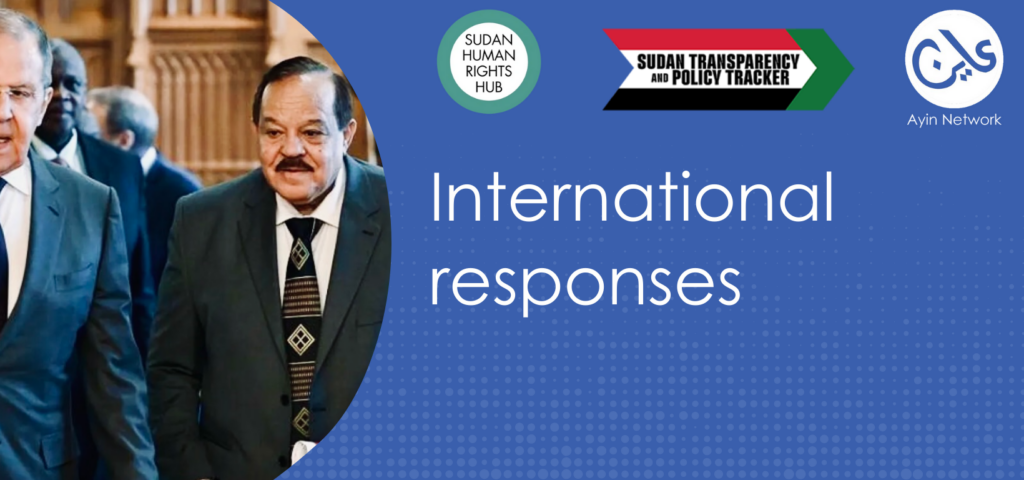
6. International responses
UN Security Council focuses on Sudan’s humanitarian situation
The UN Security Council met to discuss the situation in Sudan on February 26. The session heard from Edem Wosornu of the UN humanitarian affairs office, OCHA, who briefed the Council on the continuing deterioration of the situation in Sudan. She called on the council to take three key actions: pressing the parties to comply with international humanitarian law and protect civilians, pressing the parties to allow unhindered access for humanitarian aid, and providing adequate financing for the humanitarian response. The humanitarian response was only about 30% funded prior to the US stop work order described above and the recent UK announcement that it will be cutting aid by 40%; it is unclear how Council members will respond to this call.
Russia’s new agreement on military base
Russia and Sudan secured a new agreement on a military base in Sudan in February, following on a preliminary deal that had been agreed under the Bashir regime. If it goes through, the agreement would give Russia a toehold on the Red Sea, considered an important balance to the bases of the US and China in Djibouti. It also will allow Russia to recover in part from its loss of strategic assets in Syria following the fall of the Assad regime and help Russia expand influence in the region, including a base in Libya and connections across the Sahel. It may also be a sign that Russia may shift from its policy of supporting both sides of Sudan’s civil war to a policy more clearly supportive of the SAF.
US imposes sanctions but lacks policies
On January 7, 2025, then-US Secretary of State Antony Blinken determined that the RSF had committed genocide, saying, “The RSF and RSF-aligned militias have continued to direct attacks against civilians. The RSF and allied militias have systematically murdered men and boys—even infants—on an ethnic basis, and deliberately targeted women and girls from certain ethnic groups for rape and other forms of brutal sexual violence. Those same militias have targeted fleeing civilians, murdering innocent people escaping conflict, and prevented remaining civilians from accessing lifesaving supplies.” The same day, the US Department of the Treasury designated Hemedti and seven related companies, including one weapons supplier, for US sanctions.
Although many had initially interpreted this move as a shift by the US administration under President Biden toward a clear anti-RSF position in the progression of Sudan’s April 2023 conflict, additional sanctions against SAF Commander-in-Chief Gen. Burhan and SAF’s Defense Industries Systems (DIS) partners Ahmed Abdalla and Portex Trade Limited on January 16th, 2025 questioned whether that was the case. The US Department of Treasury noted that “Burhan’s SAF has committed lethal attacks on civilians, including airstrikes against protected infrastructure… The SAF is also responsible for the routine and intentional denial of humanitarian access, using food deprivation as a war tactic.”
On the same day that Burhan was sanctioned, unnamed US officials had also briefed the New York Times on the alleged SAF usage of chemical weapons—likely chlorine gas—in at least two locations in the past four months, with further intelligence of imminent intended usage against RSF forces in Bahri. US officials additionally indicated that only a small group of officials within SAF even acknowledged the possession of chemical weapons, with Gen. Burhan himself personally authorizing their use. While SAF officials have both publicly and privately denied these claims, and no other Western government released similar allegations in the aftermath of the NYT article, commentators in Washington, DC, believe that the US government evidence had influenced the decision to impose sanctions.
With the January 20, 2025, change in administration from Biden to Trump, US-Sudan policy remains highly unpredictable with little likelihood of action in the short term. The January 24, 2025, Executive Order on foreign aid and restructuring of the Foreign Service have already produced drastic effects on the collective international response to the Sudan crisis. While Peter Lord, a career member of the State Department with previous experience in Sudan and the broader region, has been temporarily appointed as a senior caretaker official, months are expected to pass before the Trump Administration appoints and approves a special envoy to Sudan.
Other responses are expected in the meantime. Canada, for instance, has sanctioned Al Goni Dagalo, head of RSF Finance Wing, and Merghani Idris Suleiman, head of SAF’s Defense Industries Systems, on February 7, 2025. Questions have been raised to the United Kingdom and the European Union, both of which had been previously active with their Sudan sanctions regimes, as to the likelihood of additional sanctions. The International Criminal Court (ICC) Chief Prosecutor, Karim Khan, also briefed the UN Security Council on the Darfur situation pursuant to UNSC Resolution 1593 on January 27, 2025, stating that the Office of the Prosecutor (OTP) “is taking the necessary steps to put forward applications for warrants of arrest in relation to crimes [the OTP] allege are being committed, and have been committed, in West Darfur.”



